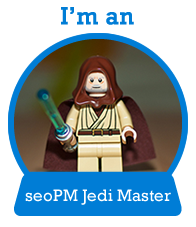Almost a month ago (time flies, doesn't it?) I had the opportunity to share a story at MozCon about SEO Project Management (seoPM) with guidelines to enhance the management of the SEO process and achieve more effective results. Since I know you're all quite busy and may need a reminder on the topic, I wanted to check in to see if you're really following the guidelines I shared... in a very fun way, of course. I present to you: an seoPM challenge!
Prepare yourself first with Yoda's seoPM advice from MozCon
For those who did not attend MozCon or skipped my SEO Project Management (seoPM) presentation on Friday morning (too much party the night before, perhaps?), take a look and prepare yourself for the seoPM Jedi challenge by checking out Yoda's seoPM advice:
Test your seoPM Force by taking the seoPM Jedi Challenge

Do you want to save it, print it, or share it? You can download this image or a higher resolution one.
There may be additional seoPM guidelines to be followed, but these are the most important principles and tips shared during MozCon. I'll share additional seoPM guidelines in future episodes, along with challenges that you will be invited to take to keep your seoPM Jedi Master status.
My seoPM Jedi Challenge Results
As it is said in Spanish, I will preach with the example: After taking the tests the result I got is that I'm an seoPM Jedi Master.

Don't get me wrong, this result doesn't mean I haven't made seoPM mistakes. Remember that you need to answer according to you latest seoPM experience, so the status can change easily. This is intentional so that you always keep following the seoPM guidelines.
The truth is, I've experienced many different situations that I've learned from along the way. I've been doing SEO since 2007 and have had a variety of different roles since then. I've worked on the agency side as an SEO consultant and afterwards as the head of the SEO department. I've also been an In-House SEO and an external freelance SEO consultant.
As you imagine, most of the stories shared by our SEO stormtrooper consultant friend at MozCon are mine, too, in some way or another. Nonetheless, I can say that after I started following Yoda's guidelines (and that are tested in the seoPM Jedi challenge), the SEO projects I manage are more effective, my clients are happier, and, of course, I'm an even happier SEO:

Disclaimer: These photos were not taken exactly at the time when the described events happened... but I promise my reaction was very similar.
This doesn't mean that if you don't follow the seoPM guidelines, you won't be able to achieve sucessful seoPM projects, or if you do, your projects are going to be perfect and issue-free. However, I'm positive that if you take these guidelines, customize them to your situation, and follow them in your every day SEO work, you will achieve your results more effectively.
Now it's your turn: Share your seoPM Jedi test results and challenge an SEO friend
I hope that we all start taking these guidelines into consideration, identifying our own situations with them, and challenging ourselves and our SEO friends to follow them.
So, as I need to challenge another SEO to get this going... I want to challenge Gianluca to take the test, share his seoPM results (and experiences) with us, and then challenge another SEO (who hasn't taken the test before) to give it a try.
Here are the different seoPM challenge badges so you can publish them along your results:
 |  |  |
Good luck with your seoPM Jedi Challenge tests. I look forward to learning about your results and stories!

